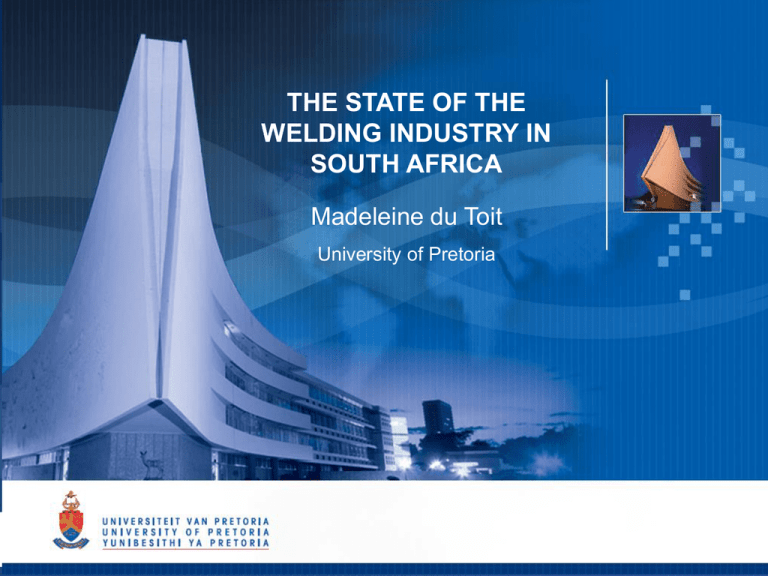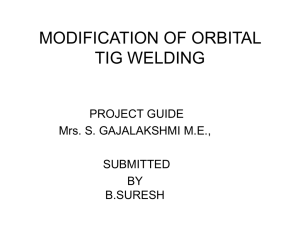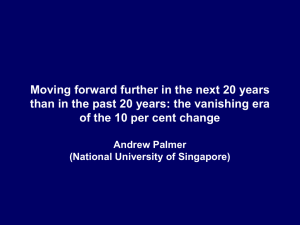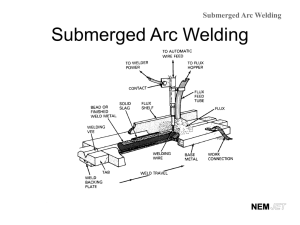the Powerpoint presentation
advertisement

THE STATE OF THE WELDING INDUSTRY IN SOUTH AFRICA Madeleine du Toit University of Pretoria 1 The year 2010 is synonymous in the public mind with the 2010 FIFA World Cup hosted by South Africa 2 But 2010 was about more than soccer … • 2010 was planned as the peak in a cycle of unprecedented infrastructure spending in South Africa. • To realize its plans to stimulate economic growth, reduce unemployment and halve poverty by 2014, the South African government put forward a set of economic proposals in 2006, called the Accelerated and Shared Growth Initiative of South Africa (ASGISA), underpinned by public investment in infrastructure. • ASGISA was developed to increase the average economic growth rate to 4.5% between 2006 and 2010, and to further accelerate economic growth to an average of 6% for the period 2010 to 2014. 3 HIGHLIGHTS OF THE INFRASTRUCTURE DEVELOPMENT PROGRAMME ESKOM NEW BUILD PROGRAMME • Construction is underway on the new Medupi power station. Medupi is a dry cooled coal-fired plant using supercritical boiler technology, comprising six units with 4 788 MW installed capacity. The boiler and turbine contracts for Medupi represent the biggest commercial contracts in Eskom’s history. • Construction has started on the new Kusile plant. This power station will consist of six units each rated at approximately 800 MW installed capacity giving a total of 4 800 MW. As such it will be one of the largest coal-fired power stations in the world, once completed, and the first power station in South Africa to have FGD technology installed. • Ingula, a pumped-storage scheme near Ladysmith, KwaZulu-Natal, with a planned capacity of 1 352 MW, is expected to be fully operational by the middle of 2013. 4 HIGHLIGHTS OF THE INFRASTRUCTURE DEVELOPMENT PROGRAMME TRANSNET • Expansion of the iron ore export channel from Sishen to Saldanha. Source: www.transnet.co.za 5 HIGHLIGHTS OF THE INFRASTRUCTURE DEVELOPMENT PROGRAMME TRANSNET • Expansion of the coal export channel by upgrading the coal link to Richards Bay and expanding capacity of the Richards Bay harbour. • New container terminal and increased capacity at the car terminal in Durban. • Widening, deepening and upgrading of the Cape Town container terminal. • Refurbishment and renewal of general rolling stock. • Continued development of the Port of Ngqura (formerly Coega) with provision for a full service container terminal. • Construction of a new 550 km 24 inch multi-purpose fuel pipeline between Durban and Johannesburg. 6 CHALLENGES Technology issues CHALLENGE: Increasing global competition. Consistent quality is the key to remaining competitive in local and global markets. • • • • • Improved control Lower defect levels Improved energy efficiency Improved integration of welding with other manufacturing processes Lower welding costs and faster deposition rates Company certification schemes such as the SAIW Fabricator Certification Scheme, based on ISO 3834. Technology Centres to facilitate knowledge transfer and support local industry with the introduction and application of advanced welding technologies, processes and materials. 7 CHALLENGES Skills shortage CHALLENGE: Shortage of skills in the welding sector. • Despite efforts by government and the private sector in recent years, the present state of South Africa’s skills pool is still depleted. • It is widely accepted that South Africa’s artisan shortage is a chronic problem. • Merseta and SEIFSA report favourable growth and predict an upward trend in the number of trained artisans in the metals industry. Most of this growth is attributed to the Accelerated Artisan Training programme. • Structured workplace experience is still a major constraint. 8 SKILLS CHALLENGES FACING THE SOUTH AFRICAN WELDING INDUSTRY • Still difficult to attract suitable people to welding-related careers. • Skilled welders, supervisors, inspectors, non-destructive testing technicians, welding technologists and welding engineers are in short supply and skilled workers are imported for large capital expansion projects, shutdowns and construction projects. • Skills levels are low and high levels of re-work are common. • Fast tracking/coaching of welders through construction code requirements is a major contributing factor to high rejection rates. 3 Months UNSKILLED WORKFORCE CODED WELDER 9 SKILLS CHALLENGES FACING THE SOUTH AFRICAN WELDING INDUSTRY • School leavers progressing through FET colleges and acquiring NQF level qualifications have a credibility issue. • Shortage of high level engineering skills in the welding industry. – Since 2006, when SAIW became the ANB of IIW in South Africa, 16 International Welding Engineers (IWE’s) have been registered in this country. – In the same period, Germany trained an average of 500 IWE’s per year. • Very little welding-related research is currently performed at South African academic and research institutions. 10 PROPOSED SOLUTIONS Targeting suitable young people by increasing the attractiveness of welding as a vocation. Actively promoting activities such as the Young Welder of the Year competition. Promoting international training schemes for welding personnel to increase the status of prestige of welding as a vocation and to provide people with a clear career paths. The introduction of bursaries, scholarships and learnerships to attract quality students. Source: www.saiw.co.za 11 PROPOSED SOLUTIONS Introduction of a national training scheme for welders and welding personnel, funded by government and the private sector. Such a scheme will ensure that: • Learners are trained by knowledgeable trainers in suitable facilities, and • Learners are trained according to a credible programme that delivers the high skills levels required by industry. Such a training scheme is already in place in South Africa !! International Welding Practitioner International Welding Specialist International Welding Inspector International Welding Technologist International Welding Engineer 12 PROPOSED SOLUTIONS Cooperative research programmes should be encouraged between government, industry and academia. Two South African Universities have sustained welding research programmes: UNIVERSITY OF PRETORIA Department of Materials Science and Metallurgical Engineering NELSON MANDELA METROPOLITAN UNIVERSITY (NMMU) Department of Mechanical Engineering 13 CONCLUDING REMARKS • Public and private infrastructure development and capital expansion projects require skilled welding personnel. • An internationally recognised national training scheme for welding personnel, industry and government funded cooperative welding research programmes and the establishment of Technology Centres are proposed to ensure that the local welding industry remains globally competitive. 14







